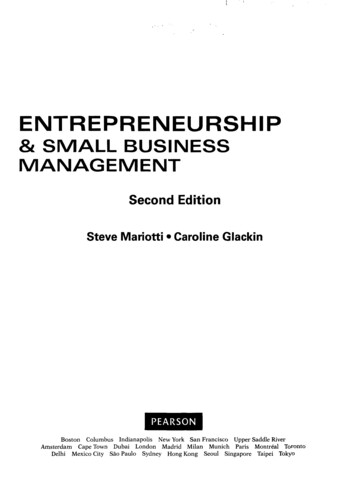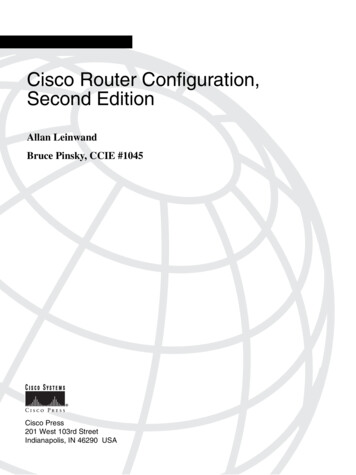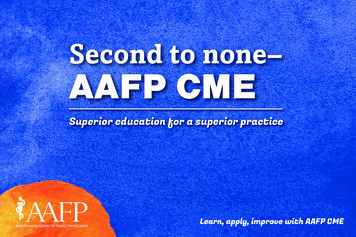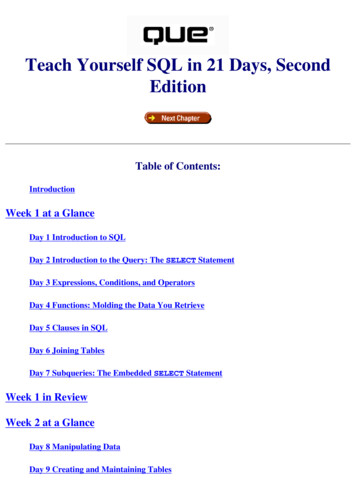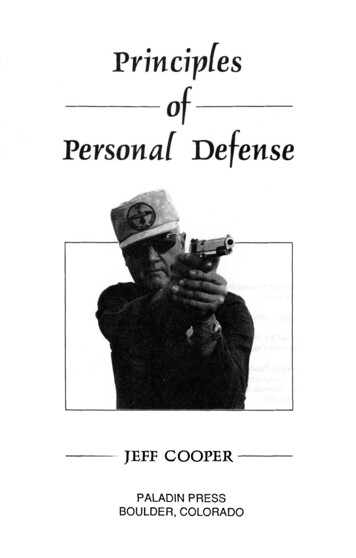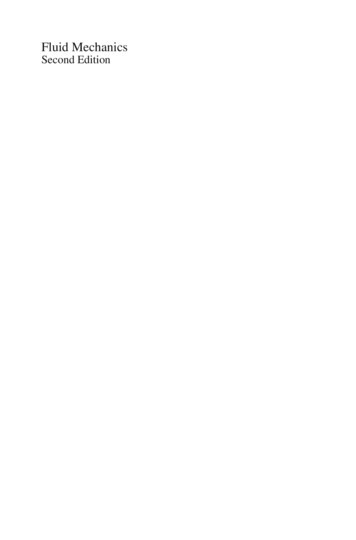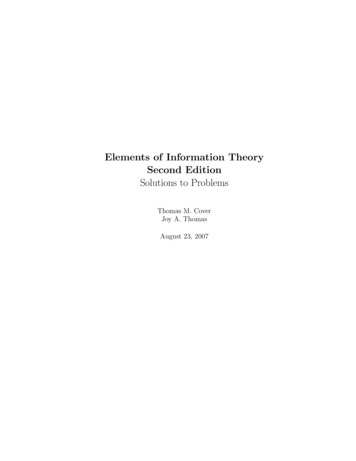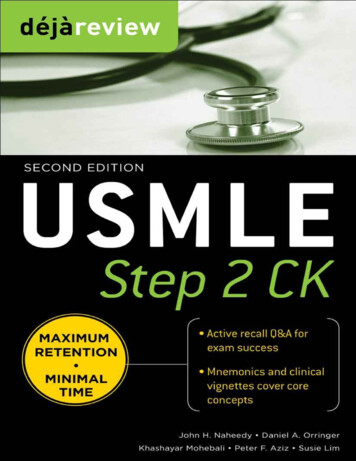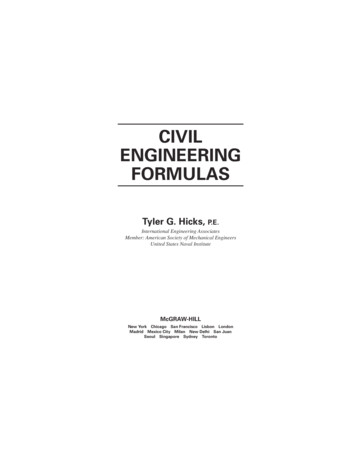
Transcription
40816 FM pi-xvii10/22/0140816HICKS12:37 PMMcghpFMPage iiiSecond Passbcj7/19/01CIVILENGINEERINGFORMULASTyler G. Hicks, P.E.International Engineering AssociatesMember: American Society of Mechanical EngineersUnited States Naval InstituteMcGRAW-HILLNew York Chicago San Francisco Lisbon LondonMadrid Mexico City Milan New Delhi San JuanSeoul Singapore Sydney Torontop.iii
abcMcGraw-HillCopyright 2002 by The McGraw-Hill Companies. All rights reserved. Manufactured in the UnitedStates of America. Except as permitted under the United States Copyright Act of 1976, no part ofthis publication may be reproduced or distributed in any form or by any means, or stored in a database or retrieval system, without the prior written permission of the publisher.0-07-139542-3The material in this eBook also appears in the print version of this title: 0-07-135612-3.All trademarks are trademarks of their respective owners. Rather than put a trademark symbolafter every occurrence of a trademarked name, we use names in an editorial fashion only, and tothe benefit of the trademark owner, with no intention of infringement of the trademark. Wheresuch designations appear in this book, they have been printed with initial caps.McGraw-Hill eBooks are available at special quantity discounts to use as premiums and sales promotions, or for use in corporate training programs. For more information, please contact GeorgeHoare, Special Sales, at george hoare@mcgraw-hill.com or (212) 904-4069.TERMS OF USEThis is a copyrighted work and The McGraw-Hill Companies, Inc. (“McGraw-Hill”) and its licensors reserve all rights in and to the work. Use of this work is subject to these terms. Except as permitted under the Copyright Act of 1976 and the right to store and retrieve one copy of the work,you may not decompile, disassemble, reverse engineer, reproduce, modify, create derivative worksbased upon, transmit, distribute, disseminate, sell, publish or sublicense the work or any part of itwithout McGraw-Hill’s prior consent. You may use the work for your own noncommercial andpersonal use; any other use of the work is strictly prohibited. Your right to use the work may beterminated if you fail to comply with these terms.THE WORK IS PROVIDED “AS IS”. McGRAW-HILL AND ITS LICENSORS MAKE NOGUARANTEES OR WARRANTIES AS TO THE ACCURACY, ADEQUACY OR COMPLETENESS OF OR RESULTS TO BE OBTAINED FROM USING THE WORK, INCLUDINGANY INFORMATION THAT CAN BE ACCESSED THROUGH THE WORK VIA HYPERLINK OR OTHERWISE, AND EXPRESSLY DISCLAIM ANY WARRANTY, EXPRESS ORIMPLIED, INCLUDING BUT NOT LIMITED TO IMPLIED WARRANTIES OF MERCHANTABILITY OR FITNESS FOR A PARTICULAR PURPOSE. McGraw-Hill and its licensors do not warrant or guarantee that the functions contained in the work will meet your requirements or that its operation will be uninterrupted or error free. Neither McGraw-Hill nor its licensors shall be liable to you or anyone else for any inaccuracy, error or omission, regardless of cause,in the work or for any damages resulting therefrom. McGraw-Hill has no responsibility for thecontent of any information accessed through the work. Under no circumstances shall McGrawHill and/or its licensors be liable for any indirect, incidental, special, punitive, consequential orsimilar damages that result from the use of or inability to use the work, even if any of them hasbeen advised of the possibility of such damages. This limitation of liability shall apply to anyclaim or cause whatsoever whether such claim or cause arises in contract, tort or otherwise.DOI: 10.1036/0071395423
40816 FM pi-xvii10/22/0112:37 PM40816 HICKS Mcghp FMPage vSecond Passbcj 7/19/01 p.vCONTENTS9.tn-Preface xiiiAcknowledgments xvHow to Use This Book xviiChapter 1. Conversion Factors for CivilEngineering PracticeChapter 2. Beam FormulasContinuous Beams / 16Ultimate Strength of Continuous Beams / 53Beams of Uniform Strength / 63Safe Loads for Beams of Various Types / 64Rolling and Moving Loads / 79Curved Beams / 82Elastic Lateral Buckling of Beams / 88Combined Axial and Bending Loads / 92Unsymmetrical Bending / 93Eccentric Loading / 94Natural Circular Frequencies and Natural Periodsof Vibration of Prismatic Beams / 96Copyright 2002 The McGraw-Hill Companies. Click Here for Terms of Use.115
40816 FM pi-xvii10/22/0140816FMHICKSviMcghp12:37 PMSecond Pass bcjPage vi7/19/01p.viCONTENTSChapter 3. Column Formulas99General Considerations / 100Short Columns / 102Eccentric Loads on Columns / 102Column Base Plate Design / 111American Institute of Steel Construction Allowable-StressDesign Approach / 113Composite Columns / 115Elastic Flexural Buckling of Columns / 118Allowable Design Loads for Aluminum Columns / 121Ultimate-Strength Design of Concrete Columns / 124Chapter 4. Piles and Piling FormulasWUW131Allowable Loads on Piles / 132Laterally Loaded Vertical Piles / 133Toe Capacity Load / 134Groups of Piles / 136Foundation-Stability Analysis / 139Axial-Load Capacity of Single Piles / 143Shaft Settlement / 144Shaft Resistance to Cohesionless Soil / 145Chapter 5. Concrete FormulasTCCRDU147Reinforced Concrete / 148Water/Cementitious Materials Ratio / 148Job Mix Concrete Volume / 149Modulus of Elasticity of Concrete / 150Tensile Strength of Concrete / 151Reinforcing Steel / 151Continuous Beams and One-Way Slabs / 151Design Methods for Beams, Columns, and Other Members / 153Properties in the Hardened State / 167UWUWFFSCSBLSCCWCGSBBCC
40816 FM pi-xvii4081610/22/01HICKS12:37 PMMcghpFMPage viiSecond PassCONTENTS9177/19/01viiTension Development Lengths / 169Compression Development Lengths / 170Crack Control of Flexural Members / 170Required Strength / 171Deflection Computations and Criteria for Concrete Beams / 172Ultimate-Strength Design of Rectangular Beamswith Tension Reinforcement Only / 173Working-Stress Design of RectangularBeams with Tension Reinforcement Only / 178Ultimate-Strength Design of Rectangular Beams withCompression Bars / 182Working-Stress Design of Rectangular Beams withCompression Bars / 183Ultimate-Strength Design of I and T Beams / 186Working-Stress Design of I and T Beams / 187Ultimate-Strength Design for Torsion / 189Working-Stress Design for Torsion / 191Flat-Slab Construction / 192Flat-Plate Construction / 195Shear in Slabs / 197Column Moments / 199Spirals / 200Braced and Unbraced Frames / 201Load-Bearing Walls / 202Shear Walls / 203Concrete Gravity Retaining Walls / 205Cantilever Retaining Walls / 208Wall Footings / 211Chapter 6. Timber Engineering Formulas3bcjGrading of Lumber / 214Size of Lumber / 214Bearing / 216Beams / 216Columns / 218Combined Bending and Axial Load / 220213p.vii
40816 FM pi-xvii10/22/0140816FMHICKSviiiMcghp12:37 PMSecond Pass bcjPage viii7/19/01p.viiiCONTENTSCompression at Angle to Grain / 220Recommendations of the Forest Products Laboratory / 221Compression on Oblique Plane / 223Adjustments Factors for Design Values / 224Fasteners for Wood / 233Adjustment of Design Values for Connections withFasteners / 236Roof Slope to Prevent Ponding / 238Bending and Axial Tension / 239Bending and Axial Compression / 240Chapter 7. Surveying FormulasCFSVC243Units of Measurement / 244Theory of Errors / 245Measurement of Distance with Tapes / 247Vertical Control / 253Stadia Surveying / 253Photogrammetry / 255Chapter 8. Soil and Earthwork FormulasPhysical Properties of Soils / 258Index Parameters for Soils / 259Relationship of Weights and Volumes in Soils / 261Internal Friction and Cohesion / 263Vertical Pressures in Soils / 264Lateral Pressures in Soils, Forces on Retaining Walls / 265Lateral Pressure of Cohesionless Soils / 266Lateral Pressure of Cohesive Soils / 267Water Pressure / 268Lateral Pressure from Surcharge / 268Stability of Slopes / 269Bearing Capacity of Soils / 270Settlement under Foundations / 271Soil Compaction Tests / 272257LALALASBCBPLCWDFCNPCFSALASH
40816 FM pi-xvii4081610/22/01HICKS12:37 PMMcghpFMPage ixSecond Passbcj7/19/01ixCONTENTSCompaction Equipment / 275Formulas for Earthmoving / 276Scraper Production / 278Vibration Control in Blasting / 280Chapter 9. Building and Structures Formulas37283Load-and-Resistance Factor Design for Shear in Buildings / 284Allowable-Stress Design for Building Columns / 285Load-and-Resistance Factor Design for Building Columns / 287Allowable-Stress Design for Building Beams / 287Load-and-Resistance Factor Design for Building Beams / 290Allowable-Stress Design for Shear in Buildings / 295Stresses in Thin Shells / 297Bearing Plates / 298Column Base Plates / 300Bearing on Milled Surfaces / 301Plate Girders in Buildings / 302Load Distribution to Bents and Shear Walls / 304Combined Axial Compression or Tension and Bending / 306Webs under Concentrated Loads / 308Design of Stiffeners under Loads / 311Fasteners for Buildings / 312Composite Construction / 313Number of Connectors Required for Building Construction / 316Ponding Considerations in Buildings / 318Chapter 10. Bridge and Suspension-CableFormulas321Shear Strength Design for Bridges / 322Allowable-Stress Design for Bridge Columns / 323Load-and-Resistance Factor Design for Bridge Columns / 324Allowable-Stress Design for Bridge Beams / 325Stiffeners on Bridge Girders / 327Hybrid Bridge Girders / 329p.ix
40816 FM pi-xvii10/22/0140816FMHICKSxMcghp12:37 PMSecond Pass bcjPage x7/19/01p.xCONTENTSLoad-Factor Design for Bridge Beams / 330Bearing on Milled Surfaces / 332Bridge Fasteners / 333Composite Construction in Highway Bridges / 333Number of Connectors in Bridges / 337Allowable-Stress Design for Shear in Bridges / 339Maximum Width/Thickness Ratios for CompressionElements for Highway Bridges / 341Suspension Cables / 341General Relations for Suspension Cables / 345Cable Systems / 353Chapter 11. Highway and Road Formulas355Circular Curves / 356Parabolic Curves / 359Highway Curves and Driver Safety / 361Highway Alignments / 362Structural Numbers for Flexible Pavements / 365Transition (Spiral) Curves / 370Designing Highway Culverts / 371American Iron and Steel Institute (AISI) DesignProcedure / 374Chapter 12. Hydraulics and WaterworksFormulasCapillary Action / 382Viscosity / 386Pressure on Submerged Curved Surfaces / 387Fundamentals of Fluid Flow / 388Similitude for Physical Models / 392Fluid Flow in Pipes / 395Pressure (Head) Changes Caused by Pipe Size Change / 403Flow through Orifices / 406FOWPTFCOMHNWFPEMCGWFEVH381
40816 FM pi-xvii4081610/22/01HICKS12:37 PMMcghpFMPage xiSecond PassbcjCONTENTS5Fluid Jets / 409Orifice Discharge into Diverging Conical Tubes / 410Water Hammer / 412Pipe Stresses Perpendicular to the Longitudinal Axis / 412Temperature Expansion of Pipe / 414Forces Due to Pipe Bends / 414Culverts / 417Open-Channel Flow / 420Manning’s Equation for Open Channels / 424Hydraulic Jump / 425Nonuniform Flow in Open Channels / 429Weirs / 436Flow Over Weirs / 438Prediction of Sediment-Delivery Rate / 440Evaporation and Transpiration / 442Method for Determining Runoff for MinorHydraulic Structures / 443Computing Rainfall Intensity / 443Groundwater / 446Water Flow for Firefighting / 446Flow from Wells / 447Economical Sizing of Distribution Piping / 448Venturi Meter Flow Computation / 448Hydroelectric Power Generation / 449Index14517/19/01xip.xi
40816 FM pi-xvii10/22/0112:37 PM40816 HICKS Mcghp FMPage xiiiSecond Passbcj 7/19/01 p.xiiiPREFACEThis handy book presents more than 2000 needed formulasfor civil engineers to help them in the design office, in thefield, and on a variety of construction jobs, anywhere in theworld. These formulas are also useful to design drafters,structural engineers, bridge engineers, foundation builders,field engineers, professional-engineer license examinationcandidates, concrete specialists, timber-structure builders,and students in a variety of civil engineering pursuits.The book presents formulas needed in 12 different specialized branches of civil engineering—beams and girders,columns, piles and piling, concrete structures, timber engineering, surveying, soils and earthwork, building structures, bridges, suspension cables, highways and roads, andhydraulics and open-channel flow. Key formulas are presented for each of these topics. Each formula is explainedso the engineer, drafter, or designer knows how, where, andwhen to use the formula in professional work. Formulaunits are given in both the United States Customary System(USCS) and System International (SI). Hence, the text isusable throughout the world. To assist the civil engineerusing this material in worldwide engineering practice, a comprehensive tabulation of conversion factors is presented inChapter 1.In assembling this collection of formulas, the authorwas guided by experts who recommended the areas ofCopyright 2002 The McGraw-Hill Companies. Click Here for Terms of Use.
40816 FM pi-xvii10/22/0140816FMHICKSxivMcghp12:37 PMSecond Pass bcjPage xiv7/19/01p.xivPREFACEgreatest need for a handy book of practical and applied civilengineering formulas.Sources for the formulas presented here include the various regulatory and industry groups in the field of civil engineering, authors of recognized books on important topics inthe field, drafters, researchers in the field of civil engineering, and a number of design engineers who work daily inthe field of civil engineering. These sources are cited in theAcknowledgments.When using any of the formulas in this book thatmay come from an industry or regulatory code, the useris cautioned to consult the latest version of the code.Formulas may be changed from one edition of a code tothe next. In a work of this magnitude it is difficult toinclude the latest formulas from the numerous constantly changing codes. Hence, the formulas given here arethose current at the time of publication of this book.In a work this large it is possible that errors may occur.Hence, the author will be grateful to any user of the bookwho detects an error and calls it to the author’s attention.Just write the author in care of the publisher. The error willbe corrected in the next printing.In add
Timber Engineering Formulas 213 Grading of Lumber / 214 Size of Lumber / 214 Bearing / 216 Beams / 216 Columns / 218 Combined Bending and Axial Load / 220 40816 HICKS Mcghp FM Second Pass bcj 7/19/01 p.vii 9 1 7 3 CONTENTS vii 40816_FM_pi-xvii 10/22/01 12:37 PM Page vii. C F S V C L A L A L A S B C B P L C W D F C N P C F S A L A S H Compression at Angle to Grain / 220 Recommendations
